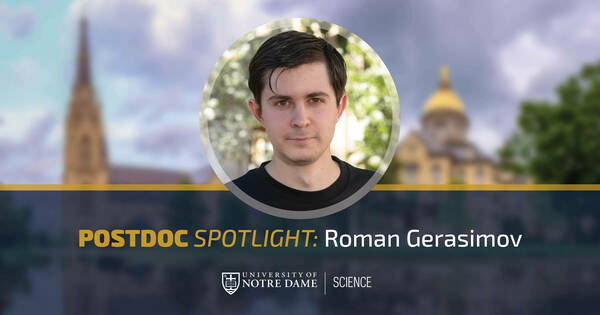
Roman Gerasimov, a postdoctoral research fellow in the Department of Physics and Astronomy at the University of Notre Dame, studies structures in our galaxy called globular clusters to examine the origins of elements — like reading a stellar history book.
“We want to find out how the galaxy evolved to get the necessary building blocks for planets like Earth — and ultimately life,” said Gerasimov. “It’s presumably a very complicated journey, but since they’re so old, globular clusters allow us to reconstruct part of that history early on.”
Stars are born together in clusters of hundreds, thousands, or even millions, packed closely. Many of the “smaller” structures, such as the one that birthed our sun 4.6 billion years ago, were not dense enough to keep all the stellar siblings together — and over a relatively short period of time, galactically speaking, the lack of sufficiently strong gravity dispersed these stars far and wide. However, much larger clusters known as globular clusters, from earlier on in the universe, contained enough gravitational force to stay together and ultimately became some of the oldest observable objects in the universe. They appear as fuzzy globes in a telescope, hence their name. Gerasimov noted that the clusters he studies date back to the earliest days of the Milky Way, some 10 billion years ago.
Besides their age that provides an unspoiled window into the past, globular clusters have a different characteristic that makes them ideal for astronomical research.
“For science in general, you like to vary one of the variables and keep the rest,” added Gerasimov. He described how astronomers don’t get to do that most of the time: “You can’t just build a star with specific parameters in the lab. You get what you get.”
Yet, for Gerasimov and other astronomers, globular clusters represent an ideal framework to conduct research since their stars are about the same age and chemical composition. It’s not perfect, Gerasimov noted, but it’s as close as he can get to an experimental setup.
Gerasimov’s interest in stellar research began at University College London, where he studied astronomy. From there, he spent five years at the University of California at San Diego, working on the same globular cluster research that he is currently doing at Notre Dame. After that, he connected to Notre Dame through Evan Kirby, associate professor in the Department of Physics and Astronomy.
“From the very first conversation that we had, it was pretty apparent to me that there was a good amount of overlap in our interests and a good level of compatibility, so that seemed like a good reason to accept the postdoc offer when I got it,” Gerasimov said.
He’s most excited to work on the large-scale projects that Notre Dame gives him access to.
“Another project I’m working on has to do with very old stars,” he said. “Not globular clusters, but the idea’s exactly the same: puzzling together the history of the galaxy from its older stars…It’s going to be a big survey using one of the largest telescopes in the world in Hawaii. This is a project that Notre Dame has access to that very few institutions do.”
Gerasimov’s contribution to this project, which is called the Subaru Prime Focus Spectrograph, involves writing code to decipher the input coming in from the telescope.
While working at UCSD, Gerasimov had a keen interest in alpine mountaineering, although he described that his recent move to Indiana — with no mountains in sight — forced him to take up running and biking instead.
“I’m in the process of actively reconsidering my hobbies,” he joked.
Originally published by at science.nd.edu on November 20, 2023.